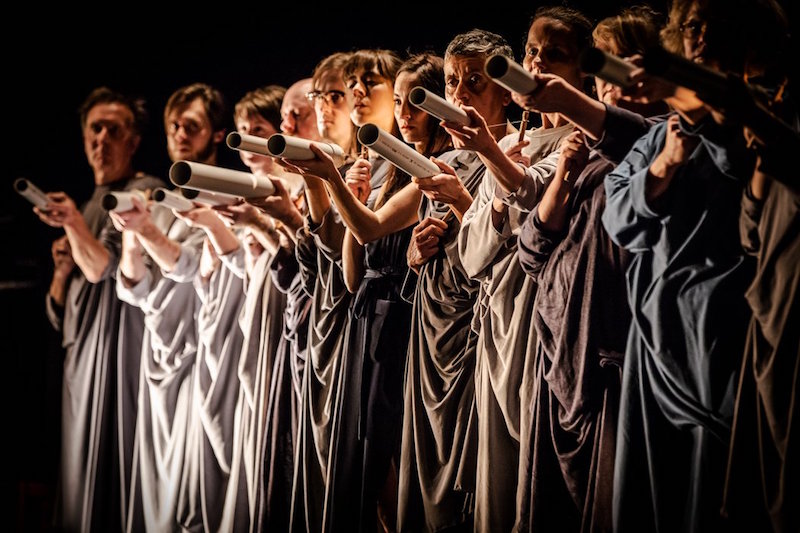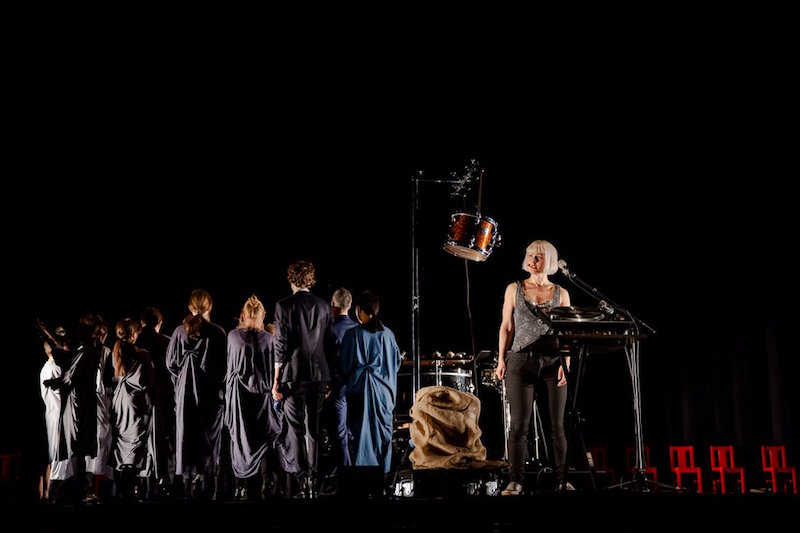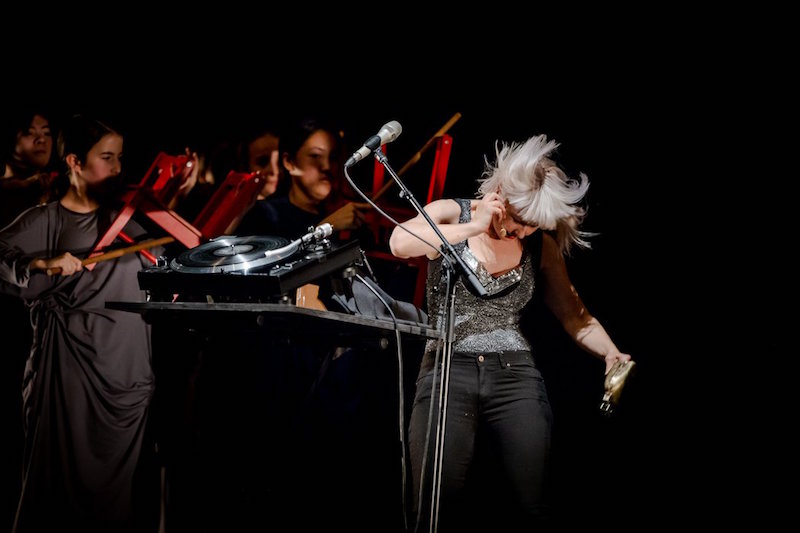Commissioned and performed by Speak Percussion with soprano Jessica Aszodi and a ‘crowd’ of trained and untrained musicians, Liza Lim’s recent large-scale composition, Atlas of the Sky, draws upon a cosmos of ideas and sounds to explore the human relationship to rituals, patterns, and stories. Central to Lim’s ambitious work are the poems of Eliot Weinberger and contemporary Chinese poet Bei Dao, which explore the question, What are the stars?, and meditate on our connections to the universe.
 Atlas of the Sky. All photographs © Bryony Jackson
Atlas of the Sky. All photographs © Bryony Jackson
Lim’s interest in ancient religious and spiritual traditions is clear from the opening of Atlas of the Sky, during which a semantron features prominently. In use as early as the 6th century AD, a semantron is a percussion instrument consisting of a large plank of wood or metal suspended by chains and struck with a mallet, and is traditionally used in monasteries as a call to prayer. Biblical narratives recount that God instructed Noah to make such an instrument to summon workers to the ark, to call them to dinner, and to invite them to rest, and the semantron is particularly important in Syrian Orthodox tradition. Indeed, Atlas of the Sky has liturgical undertones throughout, calling audiences together to consider their relationship to the cosmos, and to reflect on the epic rhythms and patterns of collective human life that stand in contrast to the turbulence of an individual’s everyday life.
The actual composition of the work is just as interesting as its conceptual and philosophical background. The semantron is merely the beginning of a vast array of instruments performed expressively and, indeed, virtuosically, by Speak Percussion’s Eugene Ughetti, Matthias Schack-Arnott, and Kaylie Melville. In keeping with the univeralist outlook of the composition, Atlas of the Sky calls for percussion instruments from many musical cultures of the world: piccolo woodblocks from Chinese opera, the Brazilian reco reco, and cowbells from Latin America and Africa, as well as the familiar Western European almglocken that quite literally hang around the necks of animals. A variety of childrens’ toys are utilised, including spinning tops and spring drums, and the Den Den Daiko, a small Japanese taiko drum.

Across the one-hour performance, a remarkably diverse range of soundscapes were extracted from this array of world percussion instruments, accompanied by the contemporary operatic performance of soprano Jessica Aszodi. Aszodi’s vocal parts carried the poetry of Dao and Weinberger. Excerpts the Weinberger’s The Stars appear in numerous iterations across the performance: ‘The stars: what are they? / They are chunks of ice / reflecting the sun; they are lights afloat on the / waters beyond the transparent dome’. Aszodi’s performance was adroit and ultimately compelling, combining myriad techniques from traditional operatic styles and spoken word to guttural throat singing. The effect, as with much of the rest of the work, was to create a relentlessly ambitious and at times overwhelming musical experience for the audience.
Furthermore, these are not static readings from the page: Aszodi, Ughetti, Schack-Arnott, and Melville roamed the stage, their dramatic performances central to the composition’s story. As they acted out their parts, they picked their way across a mob of 20 amateur performers from the community whose role is as ‘the crowd’. Throughout the piece, the crowd, variously taking their cues from one another and from the main instrumentalists, perform on rudimentary percussion instruments, including small childrens’ chairs that are used in a range of ways, from makeshift violins to drums against which rocks are pounded and scraped. Together, they convincingly represented the ebb and flow of collective thinking and action — a musical mob mentality.

Here, Lim is pushing further into the idea of human communities, relationships, and collectivities as safeguards of spritual, cosmic rituals and rhythms, some of them ancient, in a hyper-individualised, worldly culture. As in the world out there, however, the ‘crowd’ of Atlas of the Sky could be violent, primitive, and suggestible, but it can also embody wisdom, reason, and democratic desire — the mob, or the people, depending on your point of view. As the trained, virtuoso instrumentalists navigated their complex parts, one could not help but feel some affinity with the crowd, not only for representing as they did the truth, for better or worse, of our mutual dependence, but also for their plodding ordinariness against the dazzling lights of Aszodi and Speak Percussion.
The author of one anthropological study of crowd behaviours, Elias Cannetti, observed that sometimes a fire can unify an audience better than a performance. Lim’s fusion of contemporary opera and world percussion speaks to many of modern composition’s boundary-pushing sensibilities, and whether the apparent preference for more plainspoken forms contemporary classical music is collective wisdom is a question for history. The crowd at the Melbourne Recital Centre for Atlas of the Sky‘s world premiere on Monday night was, in any case, rightly impressed with the compelling performances and fascinating soundscapes conjured by Aszodi, Speak Percussion, and their 20-strong mob.
Atlas of the Sky plays at City Recital Hall as part of the Sydney Festival on January 16











Comments
Log in to join the conversation.